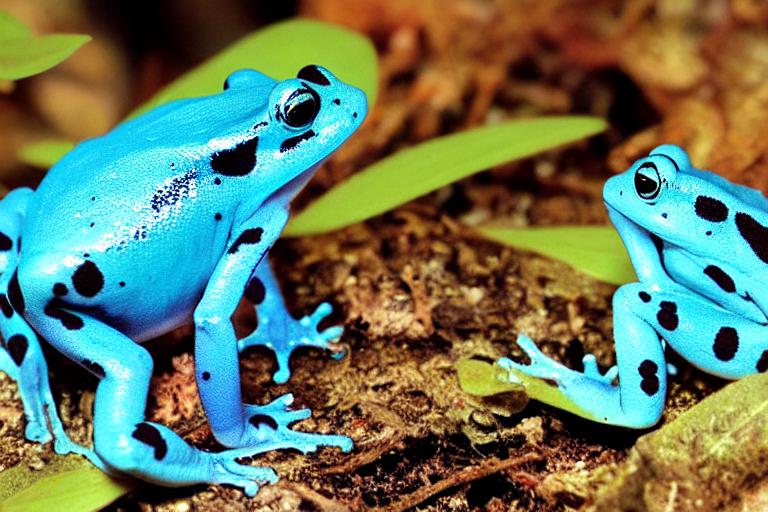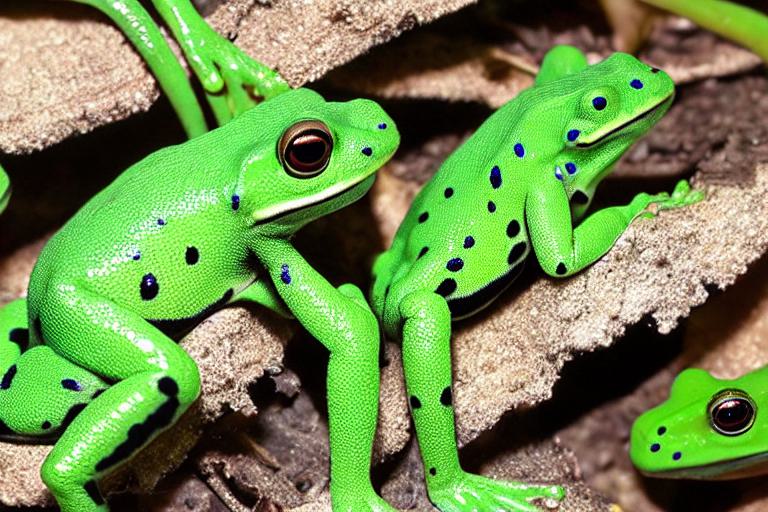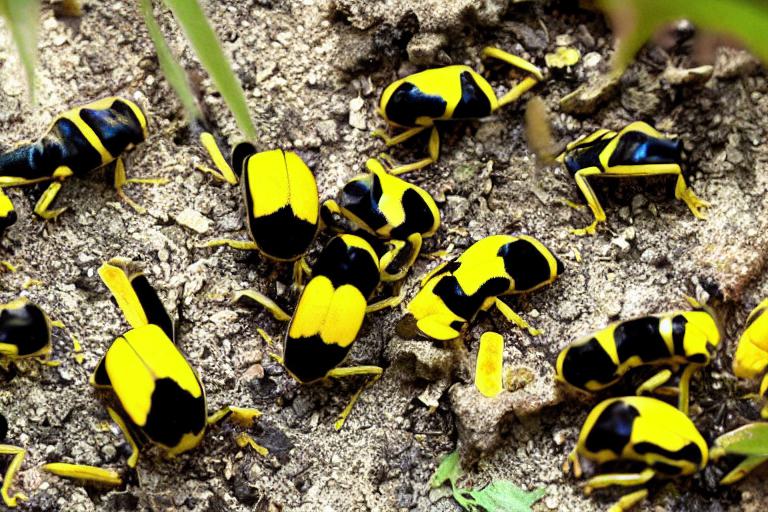A paludarium is a type of vivarium that contains both aquatic and terrestrial plants and animals. It can be a challenging environment to maintain, but it can be done. Dart frogs are a type of frog that is often kept in a paludarium. They are a tropical species of frog and require specific care. In this article, we will discuss whether or not dart frogs can live in a paludarium.
What Paludarium is Best for Dart Frogs?
Paludariums can be custom made or bought as a kit. A paludarium is a type of enclosure that is part water and part land. They are often used to house aquatic and semi-aquatic animals.
Dart frogs come in a variety of colors and patterns. They are semi-aquatic and need both land and water to survive. Dart frogs are a type of frog that is native to Central and South America.
When choosing a paludarium for dart frogs, it is important to consider the size of the enclosure. Dart frogs need both land and water, so the enclosure should be large enough to accommodate both. The enclosure should also have a tight-fitting lid to prevent the frogs from escaping.
Dart frogs are poisonous, so it is important to choose plants that are non-toxic. It is also important to consider the type of plants that will be used in the paludarium. Some good plant choices for a dart frog paludarium include ferns, mosses, and ivy.
The temperature in the enclosure should be kept between 70-80 degrees Fahrenheit and the humidity should be kept between 60-80%. Dart frogs need a warm, humid environment to thrive. The temperature and humidity levels in the paludarium should also be taken into consideration.
By taking the time to consider the needs of the frogs, you can create an enclosure that will provide them with everything they need to thrive. A paludarium is a great way to create a naturalistic environment for dart frogs.
Blue Dart Frog, Dendrobates Tinctorius “Azureus”
The blue dart frog, Dendrobates tinctorius “Azureus”, is a beautiful species of frog that is native to the rainforests of South America. The blue dart frog is a popular pet frog, and many people wonder if these frogs can live in a paludarium. These frogs are known for their vibrant blue coloration, which can vary from a light blue to a deep blue.
A paludarium is a type of terrarium that contains both land and water. The blue dart frog is an aquatic frog, meaning that it spends a lot of time in the water. In the wild, these frogs can be found near streams, ponds, and other bodies of water. This type of terrarium is perfect for amphibians, such as the blue dart frog, that need both land and water to survive.
Second, the water area should be deep enough for the frog to swim and dive. Third, the land area should be large enough for the frog to move around and explore. First, the paludarium should be large enough to accommodate both the land and water areas. If you are considering setting up a paludarium for your blue dart frog, there are a few things that you need to keep in mind.
The blue dart frog is a beautiful and popular pet frog. These frogs can live in a paludarium, as long as the terrarium is large enough to accommodate both the land and water areas.

Paludarium Requirements
In order for a paludarium to be successful, there are several requirements that must be met. A paludarium is a vivarium that contains both aquatic and terrestrial plants and animals.
First, the paludarium must have a watertight seal. Third, the paludarium must have a lighting system that can provide both light and heat for the plants and animals. This is necessary to prevent water from leaking into the living space and damaging the plants and animals. Second, the paludarium must have a filtration system to remove waste and keep the water clean.
In a paludarium, they can find the food, water, and shelter they need to thrive. Dart frogs are amphibians that need both aquatic and terrestrial habitats. If these requirements are met, then a paludarium can be a great home for dart frogs.
Green Dart frog, Dendrobates Auratus
Dart frogs are a popular pet, due to their vibrant colors and small size. However, they are also a challenging pet to care for, as they have specific needs that must be met in order to thrive. They are a brightly colored frog, with a green body and black spots. Green Dart Frogs, Dendrobates Auratus, are a species of poison dart frog found in the rainforests of Central and South America.
A paludarium, which is a type of terrarium that simulates a rainforest environment, can be a suitable home for a dart frog. In order to create a suitable environment for your frog, you will need to provide a water source, as well as plants and other objects that will help to create a humid environment. Dart frogs are a tropical species, and require warm temperatures and high humidity to survive.
When handling your frog, it is important to wash your hands thoroughly afterwards to avoid coming into contact with the toxin. In addition, it is important to keep your frog away from other pets, as the toxin can be harmful to them as well. Dart frogs are also a poisonous species, and their skin secretes a toxin that can be harmful to humans and other animals.
While they can make a fun and interesting pet, they are not a suitable choice for everyone. If you are considering getting a dart frog as a pet, it is important to do your research to make sure that you are prepared to provide them with the care they need.

Paludarium Requirements
A paludarium is a type of vivarium that contains both aquatic and terrestrial plants and animals. Paludariums can be as simple or complex as the hobbyist desires. In order to maintain the delicate balance between the two ecosystems, there are certain requirements that must be met.
This is necessary to prevent evaporation and to maintain humidity levels. The most important requirement for a paludarium is a tight-fitting lid. The lid should also have ventilation holes to allow for exchange of air.
This can be accomplished by using a liner or sealant. The bottom must be deep enough to accommodate the plants and animals that will be living in the paludarium. The next requirement is a watertight bottom.
They help to regulate humidity levels and provide a food source for the animals. A variety of plants can be used, but it is important to choose those that are compatible with the other inhabitants of the paludarium. Plants are an important part of the paludarium ecosystem.
This is necessary to maintain the proper temperature and to provide the plants with the light they need to grow. The final requirement for a successful paludarium is a heating and lighting system.
Bumblebee Dart Frog, Dendrobates Leucomelas
They get their name from their bright yellow and black coloration, which is similar to that of a bumblebee. These frogs are relatively small, reaching a maximum size of about 2 inches (5 cm). Bumblebee dart frogs are a species of poison dart frog native to South America.
These secretions can be fatal to predators, and as a result, dart frogs are often kept as pets. If they are not, their toxins will not be as potent. Dart frogs are a type of frog that is known for its toxic skin secretions. However, it is important to note that these frogs can only produce their toxins if they are healthy and well-fed.
They also need a diet of live insects, such as crickets and mealworms. Bumblebee dart frogs can make good pets, but they require a bit of care. These frogs need a humid environment, so a paludarium (a type of aquarium that simulates a wetland environment) is ideal.
These frogs can make great pets, but they require a bit of work to keep them healthy and happy. If you are considering getting a bumblebee dart frog as a pet, make sure you do your research and are prepared to provide the proper care.

Paludarium Requirements
While these frogs typically live in humid tropical forests, they can adapt to life in a paludarium as long as their basic needs are met. A paludarium is a vivarium that combines land and water elements and can be a great home for dart frogs.
The water area can be either a small pond or a water feature, and should be shallow enough that your frogs can easily get in and out. To create a suitable environment for your dart frogs, you’ll need to provide both a water area and a land area. The land area should be moist and humid, with plenty of hiding places for your frogs to feel safe.
With a little care and attention, your paludarium can be a great home for your dart frogs. Your paludarium should also have a good filtration system to keep the water clean, and plenty of live plants to help create a naturalistic environment.
Sources
Dart frogs are a great option for a paludarium, as they are small and do not require a lot of space. If you’re considering setting up a paludarium and are wondering if dart frogs can be part of your setup, you’re in luck. They are also relatively easy to care for, and their bright colors make them a beautiful addition to any setup.
Finally, the enclosure should provide plenty of hiding places and vertical space for the frogs to climb, as they are arboreal creatures. Second, the enclosure should be well-ventilated, as dart frogs are susceptible to respiratory infections. There are a few things to keep in mind when setting up a paludarium for dart frogs. First, it is important to make sure that the enclosure is escape-proof, as these frogs are small and can easily squeeze through tiny openings.
If you can provide these basic needs, then dart frogs can be a great addition to your paludarium.
Frequently Asked Questions
1. What is a paludarium?
A paludarium is a type of vivarium that contains both aquatic and terrestrial plants and animals.
2. What are the benefits of a paludarium for dart frogs?
A paludarium provides a more naturalistic environment for dart frogs and can help to promote their health and well-being. Additionally, a paludarium can provide a more aesthetically pleasing display for your frog enclosure.
3. What are some of the challenges of keeping dart frogs in a paludarium?
One of the challenges of keeping dart frogs in a paludarium is that the frogs may be more likely to escape. Additionally, it can be more difficult to maintain the correct humidity levels in a paludarium.
4. What type of substrate is best for a paludarium?
A substrate that is 50% soil and 50% sphagnum moss is a good option for a paludarium.
5. What type of plants can I include in my paludarium?
Some good plant options for a paludarium include bromeliads, ferns, and orchids.
6. What type of lighting is best for a paludarium?
A full spectrum LED light is a good option for lighting a paludarium.
7. What type of water feature is best for a paludarium?
A small waterfall or stream is a good option for a water feature in a paludarium.
8. How can I prevent my dart frogs from escaping?
Some tips for preventing your dart frogs from escaping include using a tight-fitting lid on your enclosure and adding live plants around the perimeter of the enclosure.
9. How can I maintain the correct humidity levels in my paludarium?
Maintaining the correct humidity levels in a paludarium can be challenging. Some tips for maintaining humidity levels include using a humidifier and misting the enclosure regularly.
10. Are there any other special considerations for keeping dart frogs in a paludarium?
Some other special considerations for keeping dart frogs in a paludarium include providing hiding places for the frogs and ensuring that the enclosure is escape-proof.
Final thoughts
Dart frogs are a great addition to any paludarium, as they are relatively easy to care for and are very interesting to watch. They do best in a setup that includes both land and water, and they should have plenty of hiding places to feel secure. While they are not the easiest frogs to breed, it is possible to do so in a paludarium, and it can be a very rewarding experience.
